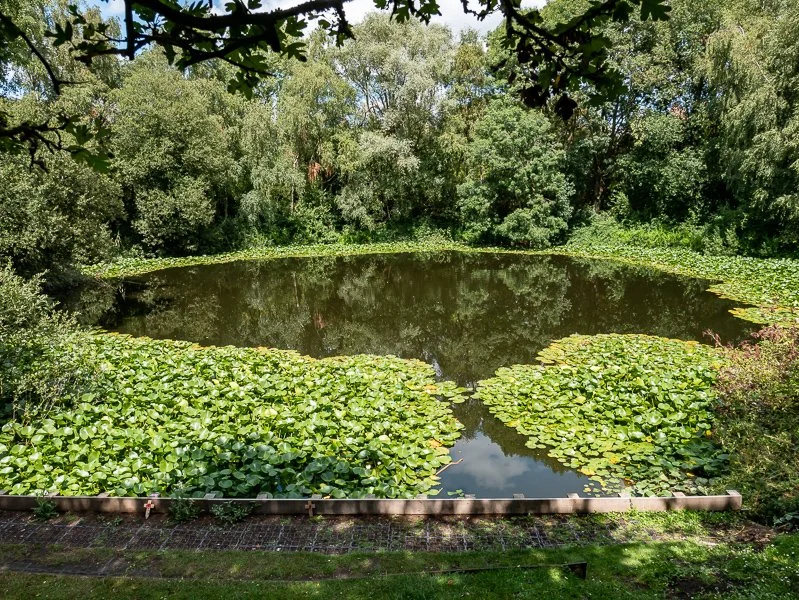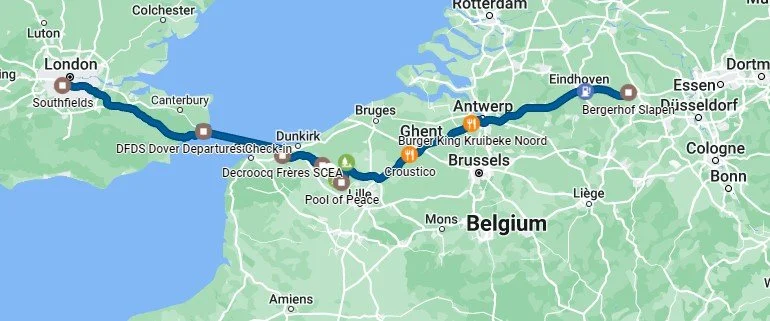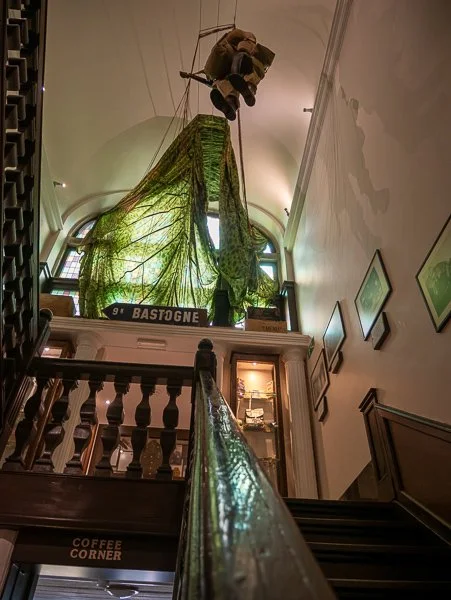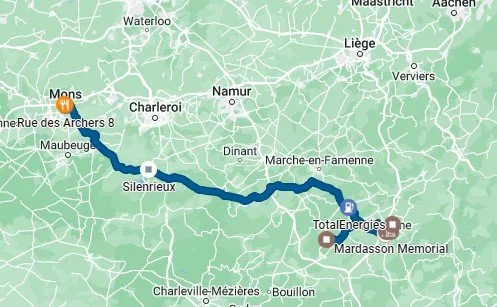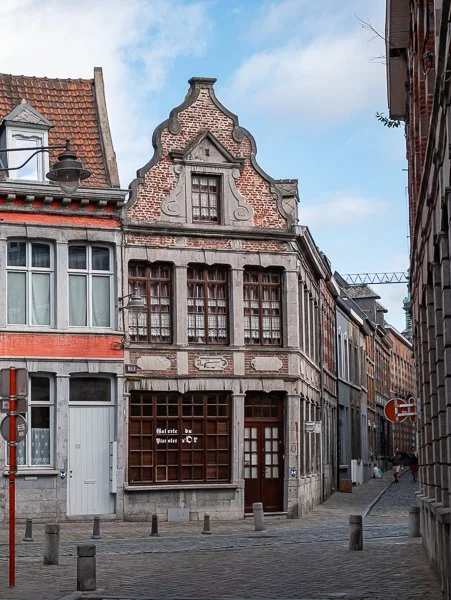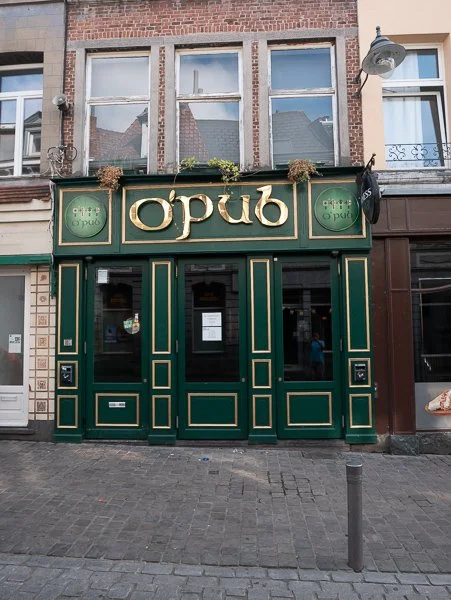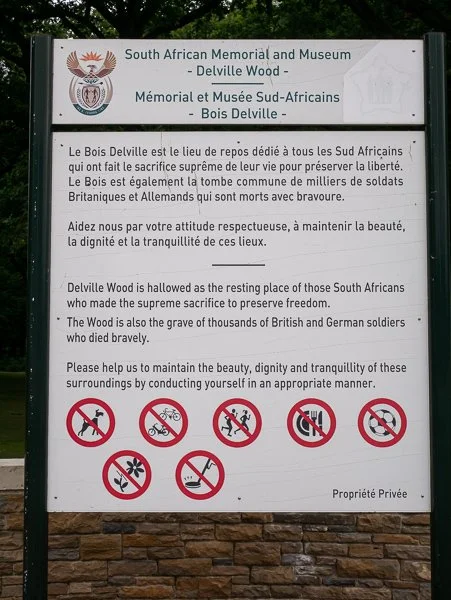France Belgium and Holland
I can't remember whether it was me or my brother who suggested the trip, the plan was to go away for a week and visit places in France and Belgium (and as it turned out Holland) where there had been some "disagreement" a century ago.
Planning was a serious business - he shared a list of places on google maps (too many to visit in a week, but it gave us choices) and I looked at them and tried to pick out an approximate route and work out where to stay. That being agreed I booked the accommodation and he booked the ferry and we were all set.
Day 1 - 29th July 2019
Dawned the day bright and sunny. Well, it might but when we set off it was still O dark thirty.
The metadata says 05:17. You will note that the Versys is packed and ready while the rider of the Italian Job is still repacking stuff and trying to get it to fit. Eventually he was ready though and off we set down to the M25 & M20 and Dover.
Given the choice I would have taken the nice quick tunnel to France rather than spending two hours on the high seas just to go a few miles, but I had known that he would book the ferry to Dunkirk.
When we got off the ferry he complained about the heat (if we'd taken the train we could have been in Belgium before it warmed up, but I'm not going to moan about that), so we stopped beside a road so that he could take off his leathers and then take off the long johns underneath. Also a pee in the French fashion (right beside the road, don't bother with a tree, that's for the uptight Eeengleesh). As is traditional on these trips it's obligatory to take pictures of fellow travellers relieving themselves - just to capture all aspects of the journey. But you don't want to see a picture of a wrinkly old feller and his wrinkly old feller, so I shall spare you.
We stopped to have lunch in Poperinge, a small, neat town in Belgium. Normally we would visit Talbot House, a place that was set up during WW1 as a club for all soldiers - rank was left at the door, and somewhere that both our grandfathers talked about visiting. With a long way still to go and some other places to visit we had to leave that for another trip.
The next stop was at the Pool of Peace, a mine crater, 129 metres in diameter and 19 metres deep. One of 19 mines that were detonated underneath German lines at the opening of that particular battle. Beautiful and peaceful now but at the time it must have been horrific.
There is also a very small cemetery (79 graves) there, Lone Tree Cemetery.


Our next stop was 13 miles up the road to Langemark Cemetery, a German WW1 cemetery. It was separated from the road by a lovely avenue of trees, and outside is a statue of four mourning soldiers.



Inside, rather than individual graves, soldiers are buried with others from their unit, mostly 20 to a plot.



44,000 wasted lives.
When we left there it was after 5pm and we were staying in Holland so it was onto the motorway and push on, stopping a couple of times for coffee and food. We arrived fairly late and the owners of the place kindly invited us to bring the bikes inside for the night before we climbed the tiny steep stairs and passed out after riding 343 miles.
I must credit my brother with the choice of places to visit, some of them he had visited before and others he had researched. But there are still so many places to visit, halfway between Poperinge and Ypres is the cemetery where Noel Chavasse is buried. A doctor who was awarded the VC and bar.
Day 2 - 30th July 2019
When we got up for breakfast it was another lovely sunny day so we (and the other guests) had breakfast outside.


The owners told us that they were restoring another old house over the road to use as a holiday rental so we went and had a look at that.


When we had discussed our plans for the day with our hosts they told us about a memorial a short distance away, so we went there first. Unless you went looking for it you would not find it by accident. It's set back a little from a tiny country road opposite fields, I would imagine that very little traffic apart from tractors passes there.



We went to Venlo to see where the Venlo Incident occurred, where two British spies were captured in Germany just a few metres from the Dutch border and which was then used by the Germans to justify the invasion of Holland.
As we were there we rode over the border (a bridge) into Germany to see if we could find somewhere for a coffee and cake, but the two places in the nearest little town were both closed.
The main visit of the day was to the Overlooon War Museum. If you are in the area then go and spend a day there, or just cycle through the vehicles hall on the bicycle bridge.
The museum is split into two parts, the first part is about the occupation of Holland and how the Dutch were treated. I had read about some of this and friends' parents had told me about how it was when they lived through it as children but it's still horrific. Not always in a graphic way, here are some Christmas decorations and the "normality" of it is chilling.
The second part of the museum is a massive mostly filled with WW2 vehicles up to Dakota size. I wish that I'd taken more pictures to include here because it wasn't just tanks and jeeps, there were mobile workshops opened up as they would be in use
I'm not quite sure why it was there, but there was a BARC


It's enormous. Huge. 4 wheel drive - one engine per wheel. Engines coupled in pairs to drive the propellers. 100 ton payload.
Up where nobody could hurt themselves on it was this device for clearing trees that were blocking roads.
Over in one corner was a display that had 1000 shells of all sizes



This is going to need more than some T-cut
I really need to go back again.
Time to head for our accommodation for the night which was in the Ardennes, so we headed south and stayed in another lovely place with lovely people. He kept his prized motorbike indoors (in the hallway) and insisted that we bring ours into the garage for the night.
Distance for the day: 191 miles
Day 3 - 31st July 2019
Today was going to be devoted to the Battle of the Bulge, and as we were chatting with our hosts before we left they gave us a great tip - which I'll share with you when we come to that part of the story.
My brother likes to claim that he's always up before me and I'm a lazy person (I am), but yet again the evidence is that yet again the Versys is ready to go first.
A short ride through the Ardennes forest brought us into Bastogne where we parked in the middle of town in Place General Mc Auliffe and left the bikes to explore on foot.
This is the last marker on the Liberty Road, placed there in 1947. They mark the route of the allied forces from D-Day. The first is outside the town hall at St-Mere-Eglise and then there is one every kilometre until this, the last one, at kilometre 1145.

This was in the 101st Museum.
I can't remember which museum it was in, but in one of them in the basement was a reconstruction of what it was like to be a civilian in a basement whilst the attack was going on. It scared me, especially when the bench we were sitting on moved.
Keeping a careful eye on the time, after walking round the town and seeing as much as we could we returned to the centre of the town for some lunch and then acted on the tip we'd been given...
If you are in Bastogne on a weekday then make sure that you are at the gates of Bastogne Barracks at 14:00 - this is the military and poor timekeeping is not acceptable.
Bastogne Barracks is still an active military base, the site of a memorable event during the battle, and as long as you are there promptly you will be welcomed in by the soldiers who will tell all about it and show you around. They do this with a great amount of pride and huge amount of gratitude to the men who fought there. In return they ask that you tell others about it so that they can visit.
The event that happened there is that of General "Nuts" Mc Auliffe. If you want to read the full story (it's worth it) then it's documented on the US Army website. But if you're impatient this is the short version.
During the battle Bastogne was surrounded by the Germans. A party of German soldiers and officers bearing white flags approached an outpost of the 101st. They had a written message which they wanted conveyed to the commanding officer.
The message essentially said "you are surrounded, if you surrender you will be treated as prisoners of war. If not we'll destroy Bastogne and anybody in it. You have two hours to reply".
The message was taken to the senior officer, General Mc Auliffe, who was asleep at the time and on being woken and read the message the first thing he said was "Nuts", and that's the reply that was sent back with the Germans (after its meaning had been explained to them).
Here's a picture of General Mc Auliffe taken at the barracks.
The window in the background of that picture is behind the picture. The wall still bears the scars.
Down in the cellar, where the US troops had their headquarters they have built a reproduction of it.
(there are other rooms)
These proud men and women are not finished with you yet you'll be signed up and the next thing you know you'll be discharged 3 years later, fully trained and with a short haircut they have a restoration centre on the other side of the barracks and you get to visit that.
A few artefacts on the way.


This being an active military base and not normally open to the public, you have been warned about there being dangerous things lying around so there are no barriers. Madame, please keep that little horror under control. And your children.





There is a big hall full of restored military vehicles and when you've seen that it's back across the barracks to be taken into another underground room. The walls of this room are lined with photographs of all the veterans who have visited (not just Americans, there are some Germans as well) and been honoured.
Go and visit.
A short ride out of town took us to the Mardasson Memorial
Because it was 17:00 when we got there it was too late to visit the museum, so we spent half an hour admiring the memorial.


Until I spotted that the approaching weather was looking a little threatening, so we rode a few more miles to our final stop of the day.
The Bois Jacques foxholes where Easy company of the 101st fought.



We had a gentle ride up to Mons, not getting there until after 9. Once we'd found where we were staying and unpacked we walked into the centre of Mons to get something to eat. I have to say that Mons at night is distinctly underwhelming and it wasn't our best night's accommodation - but it's another day tomorrow.
Distance for the day: 128 miles.
Day 4 - 1st August 2019
The owner of the house we stayed in said that we were welcome to leave the bikes parked where they were until lunchtime so after loading them up we walked the short distance into the centre of Mons.
I said that at night time I was underwhelmed with Mons, well in daytime I changed my opinion, it's a lovely place.
Although I think whoever was responsible for naming this place was not very creative.
Just before we got into the very centre of Mons there was a Boulangerie/Patisserie on a corner, with tables inside so we went inside and had coffee and unhealthy pastries for breakfast.
On the next corner was the court, with this colourful artwork outside it.


We had a wander round the back of the town hall where there was a lovely park. There was a bit of a space theme going on there, rockets made by school children and this fellow.


Suitably fed, watered and exercised we strolled back to the bikes and rode 5 or 6 miles north east on the N6, to this place. On the right there's a monument with flags and on the left a plaque with flags.
The one on the right marks where the first shots were fired by a British soldier in WW1, by Ernest Thomas although the action had started with a cavalry charge.
The plaque on the left marks the place from where the last shots were fired.



I would guess that 15 men side by side would fit across that road. Space each row at 1 yard centres (to make the arithmetic easier) and all the British soldiers killed between those flags would fill the road for 33 miles. That's before adding on Australia, Canada, India, New Zealand etc.
Back into Mons and we followed the canal a short distance to the east to stop at the place where the action happened that resulted in the first VC of the war being awarded, to Lt. Maurice Dease, and the second to Pt. Sidney Godley in defending this bridge.


"“The machine gun crews were constantly being knocked out. So cramped was their position that when a man was hit he had to be removed before another could take his place. The approach from the trench was across the open, and whenever a gun stopped Lieutenant Maurice Dease... went up to see what was wrong. To do this once called for no ordinary courage. To repeat it several times could only be done with real heroism. Dease was badly wounded on these journeys, but insisted on remaining at duty as long as one of his crew could fire. The third wound proved fatal, and a well deserved VC was awarded him posthumously. By this time both guns had ceased firing, and all the crew had been knocked out. In response to an inquiry whether anyone else knew how to operate the guns, Private Godley came forward. He cleared the emplacement under heavy fire and brought the gun into action. But he had not been firing long before the gun was hit and put completely out of action. The water jackets of both guns were riddled with bullets, so that they were no longer of any use. Godley himself was badly wounded and later fell into the hands of the Germans"
It was only a 3 mile ride back into Mons so we parked in the town square and had lunch outside.


After our brief, two hour, lunch break we headed out again. I remember that round the back of the square some builders were working and they had Jack Russell which started barking at me as we were waiting for the traffic to move. When I moved off it stopped barking and launched itself at me clamping its teeth onto my boot. I was a bit worried (not for my boot or toes) that when it fell off I might run it over so I kept the speed right down until it realised that it was not going to win this fight.
I salute you little dog, maybe 5 kilos taking on 330. True bravery or lunacy. I'm not sorry that I laughed at you though.
Four miles southeast of Mons is St Symphorien Military Cemetery. Although it is now cared for by the Commonwealth War Graves Commission it was originally built by the Germans. The land was given to them on condition that the dead of both sides be treated with equal respect.
Because of this the layout is different to "regular" CWGC cemeteries.


Maurice Dease, along with others killed in the Battle of Mons, is buried here.
At the back of the cemetery are these two rows (slightly distorted as I had to make a panorama). The two headstones with wreaths on them are not quite toe to toe, but between them lie a million others.
The one on the left is that of Private John Parr, believed to be the first commonwealth soldier to be killed, and the one on the right Private George Ellison, believed to be the last.



These graves are of the Middlesex Regiment, the German monument calls them the Royal Middlesex Regiment. My brother tells me that the Germans buried them in a circle like this because their shooting was so good that they believed them to have been a company of marksmen.


We had a way to go because I'd booked somewhere in Arras for the next three nights (the rest of our stay) and we needed to get there at a reasonable hour to pick up the key. But when we left the cemetery a mature gentleman approached us and in broken English (but still a thousand times better than our French and as for Flemish...) insisted that we come with him.
We tried to explain that we had to be somewhere, but he kept insisting that we must come with him for a drink. Well we reckoned that we were probably safe enough, we're too old and far to ugly to be sold as sex slaves and if you were going to nick the bikes you'd go for something a bit more expensive (and newer in the case of my brothers).
So we followed him down the hill back into the village and he pulled in at one of the first houses. When we went inside Christian introduced us to his wife, Marie-Claire and we all went outside onto the balcony where there was a bottle of wine (and he fetched some fruit juice for us), and as we chatted he explained why he had invited us. This is the short version...
He had lived in the village all his life and as a boy when the Germans invaded (WW2, none of us are that old) they took his father as a slave labourer and he didn't see him for the rest of the war. Much later (it must have been near the end of the war) the British had got there. The Germans were using aircraft to attack the British soldiers, who were trying to shepherd the locals to safety, and as he was running with the soldiers a plane attacked, one of the soldiers took off his tin helmet and put it on Christian. An act that he was grateful for to this day.
He also told us about how it was when his father was finally freed and came home. When his father was being rounded up he'd picked up one of Christian's toy cars and taken it with him to remind him of his family. When he came back he took the toy out of his pocket and gave it back.
When he'd seen the bikes go past with British plates on them he'd gone up to the cemetery because he still wanted to say thank you for that act of kindness and he appreciated people coming to visit those that didn't get to go home.
By now there was a lot of dust blowing around and it kept getting in my eyes.
We stayed as long as we could but eventually we had to say goodbye and ride back into France to Arras.
Distance for the day 89 miles. Humbled.
Day 5 - 2nd August 2019
The action today starts a mere hour into the day. At 1am I was in bed asleep when my brother burst through the door in excited mode. "Quick, come and see, a drunk driver nearly hit your bike!"
"Is that nearly hit but missed?"
"Yes but you've got to come and see, there's plain clothes police with guns"
I'm awake now, so I might as well get up and see and then he won't be telling me about it all morning (spoiler, he did anyway).
So we leaned out of the window to watch the action below. There were the passers by who had pulled the drunk out of his car, the two plain clothes cops who had happened to be passing in an unmarked car and were cuffing the perp. Action over and back to bed.
The next morning we wandered up the road to a patisserie to get some artery cloggers for breakfast and surveyed the scene.
I had parked my bike in this little triangular bit of pavement, thinking it would be out of the way.
Monsieur le Villain had come down the hill and crashed into the corner of the triangle and stopped beside my bike.
It turned out that it hadn't escaped unscathed. The police had rolled it backwards a little to pull him out and the lock had dinged the mudguard, but I didn't notice it until I was back home (and completed another tour) so it took me a while to work out where it had happened. C'est le vie as they say. Cosmetic damage.
Le Rozzers pushed the drunkmobile back into the parking bay out of the way.
On the way back with our breakfast Colombo and I pieced together some of what had happened. The idiot had ignored the no entry sign and the bicycles only sign and drove down this bicycle lane "massaging" the bollard on his way, then drove the wrong way down the one way street until it became two way and he got to my bike.


My brother, very kindly I thought, picked up the wheel trim and a big chunk of wheel arch liner from the bicycle lane and put them on the windscreen, he also added a card for a local taxi company - "He'll be needing this"
Breakfast consumed we set off on foot to see the Citadel. Now, if my brother had said to me "it's very close to the military cemetery where great uncle Albert is listed in the names with no known grave" then I would have said "ok, we head west until we get to the ring road and we will be very close.
Instead he said "It's beside the football ground". Note the use of "the" in that. Off we set in a southerly direction. I was a bit concerned at the sign with the French equivalent of "You are now leaving Arras" and the other one "Welcome to..."
It's a good job that I was wearing walking boots and not bike boots!
Finally "There must be more than one football ground", yes at least one per town.
"Where is this place?" I asked, "Do you remember when we came to the cemetery to lay the wreath underneath where great uncle Albert's name is? Well it's right next to there"
No point in getting upset, I shouldn't have believed that he could actually navigate anywhere besides it will give me ammunition to take the piss out of him for years to come.
Because of our unorthodox route to the Citadel we arrived behind it and entered through the back door (you can make up your own jokes here.)
Down here (I don't know if it was built as a moat) 218 members of the resistance were executed by firing squad.
The memorial plaques go round the corner and all the way to the end of the next section.
I do like nice brickwork, this is about 350 years old.



The chapel was nearing the end of its restoration. Wikipedia describes it as a "Baroque-style chapel", as it was built before Bach (JS) was born. I think it could probably just be described as Baroque.
And out through the in door
Surprisingly when we walked back into Arras for lunch it was a much shorter walk. Granted the navigation was also easier, just look out for old towers (although rebuilt after WW1) sticking up and walk towards them. If only football grounds were grouped together like that.
After lunch we went for another stroll, I made sure of the directions before we left, but as we had walked most of the way there in the morning I was already sure of the way. We went to visit the Wellington Tunnels, the tunnels that were used to hide troops during WW1 and as civilian air raid shelters in WW2.
The tunnels date back to the middle ages, but during WW1 they were extended by Kiwi's and Royal Engineers to a total of about 20 km. Thousands of soldiers were living down there just before the Arras offensive when the exits were "opened" with dynamite and the soldiers rushed out to surprise the Germans.
You have to wear a helmet to go down, but you get issued with a "tin" hat for the duration. It contains as much tin as my wooden leg, but looks better than a yellow hat.
On a hot summer's day the temperature 20m underground was very nice, but it was also cool in the other sense of the word.
In places the walls have graffiti on them written and drawn by the soldiers, which due to the lack of light (and no doubt some luck during WW2) must look pretty much as it did when it was created. The signs are still on the wall pointing to places with familiar names (the tunnels were given names of places that the soldiers would be familiar with).
There are telephone wires high up on the wall, and because the insulators are glass that helps date them - at a certain point porcelain insulators were introduced.
There are still a few bunk beds down there and some of the carts that were used to carry spoil out on a railway.
You can see where the exits were that the soldiers used to attack from.
There are traces of their use as WW2 shelters as well, they are signs painted on the walls in red.
Flash photography is (rightly) not allowed down there so the only picture is one my brother took of me looking like a ghost from the
Just around the corner from the tunnels is a memorial to the New Zealand tunnelers
That evening we rode up to Notre-Dame de Lorette, but not to see the museum there which was closed for the day.
We had come to see L'Anneau de la memoire, a big oval monument that inside is lined with panels that list the names of all the soldiers who died in northern France in 1914-1918. High up on one of them is our great uncle Albert.



When we arrived there were a few other people there and a few more came and went, but as it got later everybody else left. The sun was now moving through the last bit of sky before it made way for night. As it did, for a short while the colour of the panels intensified.






A few minutes more and the day was finished. We stayed up there for a while longer enjoying the view of the lights of the towns and cities below and the synchronised beacons on the wind turbines.



Distance for the day 47 miles ridden and 10 walked.
Day 6 - 3rd August 2019
Our last day before returning home and plenty of interesting places to see so after breakfast we set off. Our first, brief, stop was at Flesquieres to see the tank Deborah. But since my brother had last been there a new visitors centre had been built and the tank moved inside - and it doesn't open until afternoon.
Should you wish to check the opening times - Visit Deborah at Flesquieres
"Right" he said "We'll go and visit Guillemont church which has a memorial to the Liverpool Pals killed in the battle there, I've been there before. We go that way" he said, waving his arm.
"Ok," I replied "we're going that way then" and pointed in the opposite direction.
On the outside the church is fairly normal looking, it blends in with the village, but inside it is very brightly decorated (I believe the theme is peace)



Just outside the village, only a short distance away is Delville Wood. On one side of the road is a large CWGC cemetery and on the other the South African Memorial and Museum, which we had come to visit.
When you go through the gate the memorial is at the end of a long walk with a double row of oak trees either side. When the memorial was built in the 1920's acorns were taken from an oak tree growing in South Africa. That tree had in turn been grown from an acorn planted in 1688 by a French Hugenot settler.
Before you pass through the arch ahead you go past the altar stone in the curve of the walls. Ahead of you is the memorial and museum and behind you the cemetery. In the centre of the museum is the cross. The whole building is beautiful. It's just a pity that thousands had to be slaughtered to get such a memorial.






When we had finished looking at the museum we (as you must do if you visit) left the building and walked into the woods behind it. All of the trees were replanted by the South African Department of Forestry.
There are wide open "rides" in the same locations as they occupied before the war, each named with street names that would have been familiar to the troops - Regent Street, Bond Street. The names are shown on stone markers.
But either side of them are the real memorials, the remains of the trenches.
As I stood looking at the trenches and wondering how many bodies lay amongst them I got the feeling that they welcomed me, and were pleased that people came and remembered them.



There is one tree that wasn't planted after the war, this is the "last tree". The only one from the original woods that survives. The trunk has pieces of shrapnel embedded in it.


If you are nearby then go and visit even if, like me, the nearest that you've come to South Africa is watching Nelson Mandela on television.
It was now past lunchtime (for the French) so we went to the Old Blighty Tea Rooms and had a leisurely lunch (with multiple cups of tea of course) and looked at the artefacts there.
Half a click away is the Lochnagar crater. Miners tunnelled to within 100ft of the German trenches and placed two charges 60 ft apart, one of 36,000 lbs of ammonal, the other of 24,000 lbs.
We're very effective (good is not the right word) at killing each other.
Our next stop was at Villers-Bretonneux, where on the hillside is a CWGC cemetery, with behind it the Australian National Memorial and behind that the Sir John Monash Centre. The tower of the Australian National Memorial is pockmarked with scars from WW2, when the German army and Luftwaffe attacked it while it was being used as an observation post by the French.


The Sir John Monash Centre tells the story of the Australians in WW1. The building itself is stunning. I don't think I've ever been in such architecturally amazing toilets. While I was relieving myself in them my brother entertained himself by using my camera to make a 4k video of himself gurning. This was significant later.
On the way back through the cemetery I was looking at the headstones and saw this one,
With a small plaque on the ground in front of it added exactly a century after his death.
Every time I read that it moves me. It contains a lesson about service that most politicians will probably never understand.
After that we went to visit the local prison, which might sound like a strange thing to do.



Does it look like the wall has been repaired at some time?
As I finished taking that picture and was walking back across the road a group of prison officers walked along the pavement, obviously having just clocked off. They looked at me a bit suspiciously as I was taking pictures of their prison. Amiens Prison. "Operation Jericho '' I said, and they smiled and nodded.
Up the road is the local municipal cemetery and at the back of that a small CWGC cemetery.


Just after I'd taken those pictures my camera ran out of memory - because I was running with a large memory card I hadn't brought any spares that day. Also I didn't know about the gurning videos otherwise I could have reclaimed plenty, so the last few pictures are going to be from my phone.
We had just one more place to visit now, but as it was going to be very late by the time we got back to Arras we stopped on the way at a branch of the golden arches, sitting outside and enjoying what was almost the last sun of the day.
About halfway along the completely straight road to Bapaume, at about the highest point there are two memorials, one either side of the road.
On the north west side is the Windmill Memorial to Australian forces who died here, and on the south east the tank memorial.
This is where tanks first saw action in 1916. It's peaceful now, none of the horrendous mud that you see in the historical pictures is visible, just neat fields in the evening sun.
Around the memorial are four model tanks representing different marques of tanks used. Surrounding the monument on three sides is a chain fence. The chain is a drive chain from some of those first tanks and the fence posts are the barrels of their six pounder guns.



And that was it, we've seen as much as we can on this trip.
We had a gentle ride through the darkness, back to Arras and did as much packing and tidying as we could before turning in for the night.
Distance for the day: 123 miles.
The next day was an easy one, get up, have breakfast, finish packing and tidying and head back to Dunkirk and the ferry home. Of course once we were back on the British side of the channel driving standards fell to levels of stupidity that we hadn't seen in the rest of our trip.
152 miles after leaving Arras and I was home, my brother had another hundred to do but he stayed the afternoon before going on.
A month later we met up and headed down to Lake Como for a long weekend, but that is a tale for another time.

